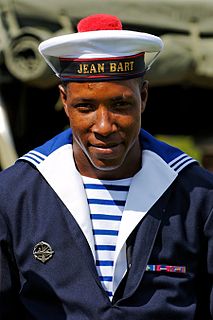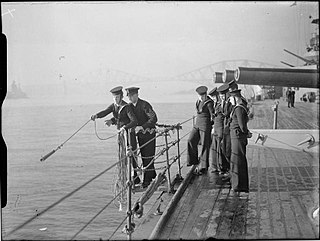Related Research Articles

A non-commissioned officer (NCO) is a military officer who has not pursued a commission. Non-commissioned officers usually earn their position of authority by promotion through the enlisted ranks. In contrast, commissioned officers usually enter directly from a military academy, officer candidate school (OCS), or officer training school (OTS) after receiving a post-secondary degree.
A midshipman is an officer of the lowest rank, in the Royal Navy, United States Navy, and many Commonwealth navies. Commonwealth countries which use the rank include Canada, Australia, Bangladesh, Namibia, New Zealand, South Africa, India, Pakistan, Singapore, Sri Lanka, and Kenya.

In a navy, a rate, rating or bluejacket is a junior enlisted sailor who is not a warrant officer or commissioned officer. Depending on the country and navy that uses it, the exact term and the range of ranks that it refers to may vary.

Seaman recruit (SR) is the lowest enlisted rate in the United States Navy, U.S. Coast Guard, and the U.S. Naval Sea Cadet Corps just below seaman apprentice; this rank was formerly known as seaman third class. Two separate pay grades exist within this rank — one for those with service of less than four months, with a higher pay scale for those in service for more than four months, even if they have not yet advanced to seaman apprentice.

Impressment, colloquially "the press" or the "press gang", is the taking of men into a military or naval force by compulsion, with or without notice. European navies of several nations used forced recruitment by various means. The large size of the British Royal Navy in the Age of Sail meant impressment was most commonly associated with Great Britain and Ireland. It was used by the Royal Navy in wartime, beginning in 1664 and during the 18th and early 19th centuries as a means of crewing warships, although legal sanction for the practice can be traced back to the time of Edward I of England. The Royal Navy impressed many merchant sailors, as well as some sailors from other, mostly European, nations. People liable to impressment were "eligible men of seafaring habits between the ages of 18 and 55 years". Non-seamen were sometimes impressed as well, though rarely. In addition to the Royal Navy's use of impressment, the British Army also experimented with impressment from 1778 to 1780.
A Petty Officer (PO) is a non-commissioned officer in many navies and is given the NATO rank denotation OR-5 or OR-6. In many nations, they are typically equal to a sergeant in comparison to other military branches. Often they may be superior to a seaman, and subordinate to more senior non-commissioned officers, such as a chief petty officers.
Seaman apprentice is the second lowest enlisted rate in the U.S. Navy, U.S. Coast Guard, and the U.S. Naval Sea Cadet Corps just above seaman recruit and below seaman; this rank was formerly known as seaman second class.

Seaman is a military rank used in many navies around the world. It is considered a junior enlisted rank and, depending on the navy, it may be a single rank on its own or a name shared by several similarly junior ranks.

Quartermaster is a military term, the meaning of which depends on the country and service. In land armies, a quartermaster is generally a relatively senior soldier who supervises stores or barracks and distributes supplies and provisions. In many navies, a quartermaster is an officer with particular responsibility for steering and signals. The seaman is a non-commissioned officer rank; in some others, it is not a rank but a role related to navigation.
Leading seaman is a junior non-commissioned rank or rate in navies, particularly those of the Commonwealth. When it is used by NATO nations, leading seaman has the rank code of OR-4. It is often equivalent to the army and air force rank of corporal and some navies use corporal rather than leading seaman.

A boy seaman is a boy who serves as seaman or is trained for such service.
Able seaman is a military rank used in naval forces.
Ordinary seaman is a military rank used in naval forces.
Master's mate is an obsolete rating which was used by the Royal Navy, United States Navy and merchant services in both countries for a senior petty officer who assisted the master. Master's mates evolved into the modern rank of Sub-Lieutenant in the Royal Navy, while in the merchant service they evolved into the numbered mates or officers.
Young gentlemen is an archaic term that was used in the Royal Navy to refer to boys aspiring to become a commissioned officer. Until promotion to lieutenant, these boys would serve in various ratings, and the term was used to group all these boys together. A similar term today would be officer candidates or cadets.

The Kriegsmarine was the navy of Nazi Germany prior to and during World War II. Kriegsmarine uniform design followed that of the preexisting Reichsmarine, itself based on that of the First World War Kaiserliche Marine. Kriegsmarine styles of uniform and insignia had many features in common with those of other European navies, all derived from the British Royal Navy of the 19th century, such as officers' frock coats, sleeve braid, and the "sailor suit" uniform for enlisted personnel and petty officers.

Royal Navy ranks, rates, and uniforms of the 18th and 19th centuries were the original effort of the Royal Navy to create standardized rank and insignia system for use both at shore and at sea.
References
- ↑ Oxford English Dictionary
- ↑ Rodger, N. A. M. (1986). The Wooden World: An Anatomy of the Georgian Navy. Annapolis, Maryland: Naval Institute Press. pp. 227–228. ISBN 0870219871.
- ↑ Williams, Glenn F. (April 2002). "Uncle Sam's Webfeet: The Union Navy in the Civil War" (PDF). International Journal of Naval History. 1 (1). Retrieved 27 August 2012.
- ↑ Malin, Charles A. (19 May 1999). "Compilation of Enlisted Ratings and Apprenticeships, U.S. Navy, 1775 to 1969". Naval Historical Center. Archived from the original on 16 September 2012. Retrieved 1 January 2008.